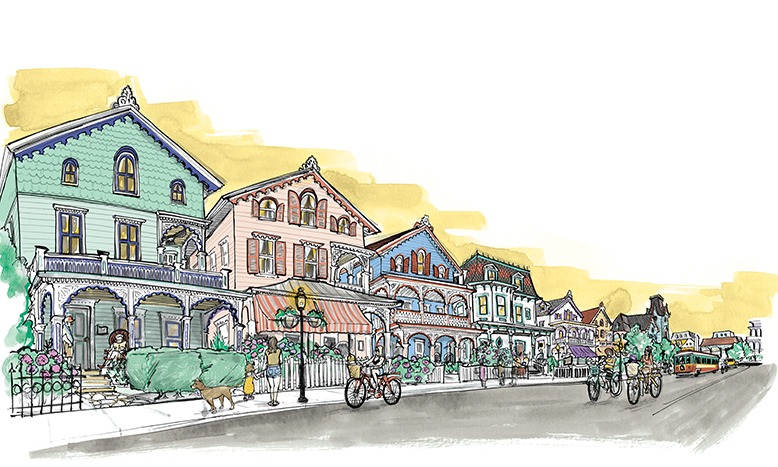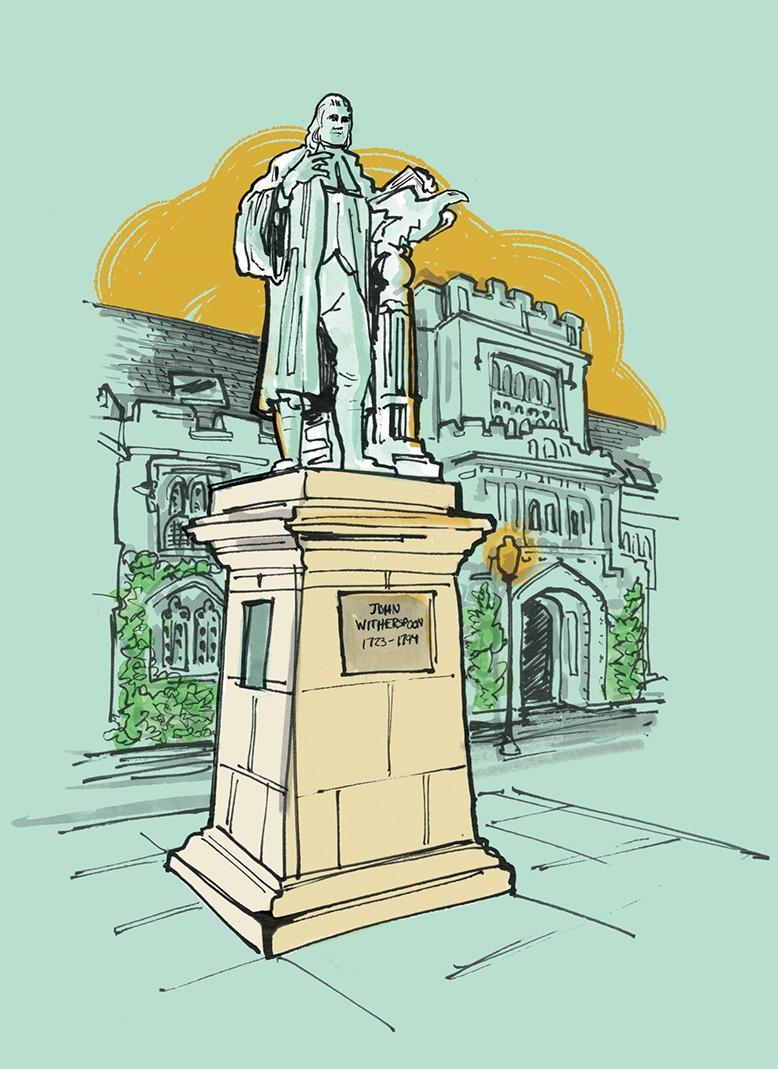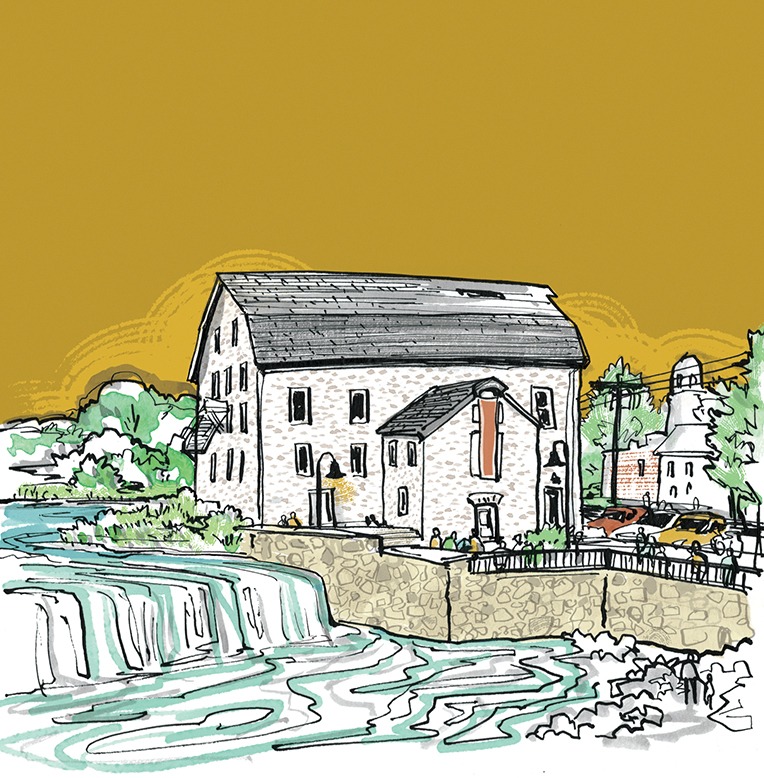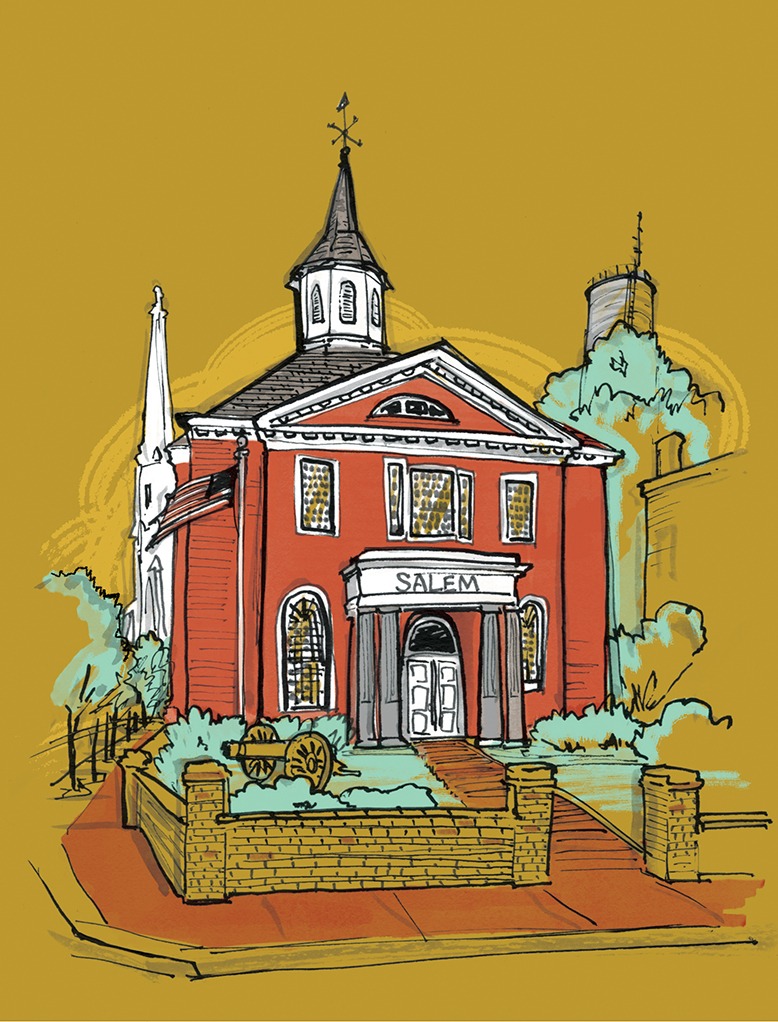
Cape May Illustration by Brett Affrunti
Many of New Jersey’s oldest towns have fascinating histories, plus a host of fun, interesting and even spooky sights to visit today.
Discover the momentous events preserved at these 10 historic destinations all over the state, from Princeton to Cape May to New Brunswick to Morristown.
CAPE MAY
Cape May County
FOUNDED: In 1620, the same year Pilgrims arrived in the New World, Dutch sea captain and explorer Cornelius Jacobsen Mey charted the area that, in 1869, was named in his honor (with an Anglicized spelling).
THE STORY: The city of Cape May evolved from a fishing and whaling community to seaside resort as early as the mid-1700s. Tourism burgeoned in 1816 with the opening of the city’s first hotel, the original Congress Hall. In 1976, the entire city of Cape May was designated a National Historic Landmark—the only U.S. city so honored. Today, Cape May boasts the second largest concentration of gingerbread-trimmed Victorians (upwards of 600) in the nation, second only to San Francisco.
THE SIGHTS: The Emlen Physick Estate, built in 1879, is the only Victorian house in town open as a museum; guided tours are available daily. To see more of the city, take a narrated trolley or walking tour, many offered by Cape May MAC, a nonprofit dedicated to the area’s cultural enrichment. During the holiday season, Cape May MAC conducts interior tours of additional Victorians. Cape May MAC also maintains the 1859 Cape May Lighthouse and the World War II Lookout Tower, both in Cape May Point. Each affords a panoramic ocean view. The city’s oldest surviving residence, the Memucan Hughes House, built circa 1775, was a residence, tavern and possibly a brothel; it is open seasonally for guided tours. And don’t miss the new Harriet Tubman Museum, dedicated in September 2020 to honor the legendary Underground Railroad activist.
NEARBY: The Museum of Cape May County, in Cape May Court House, 12 miles north of the city, features a 1704 house with an 1830 addition, a 1780 barn, and a carriage shed with antique vehicles. Historic Cold Spring Village, an outdoor living-history museum, recreates rural life from the early-to mid-19th century. At Sunset Beach in Lower Township, you can see the visible remains of a sunken concrete ship, the S.S. Atlantus, one of 12 experimental ships built during and after World War I. This one broke loose from its moorings in 1926 and has jutted out of the ocean ever since. Other area attractions include wineries, breweries, an aviation museum and the Cape May County Park & Zoo.
VINTAGE EATS: Dine indoors or on the veranda at the Magnolia Room Restaurant in the Chalfonte (301 Howard Street), Cape May’s oldest standing hotel.—Barbara Leap
***

Illustration by Brett Affrunti
PRINCETON
Mercer County
FOUNDED: The first European settlers arrived in the 1680s; in 1724, the settlement acquired the name Prince Town, just down the road from Kings Town, which is now Kingston.
THE STORY: Home to Princeton University and a centuries-long roster of notable Americans, this venerable municipality boasts more history per square foot than any other place in New Jersey.
THE SITES: The densest concentration of all, just two short blocks from the heart of town, is the Princeton Cemetery, where a brief, shady stroll will take you from Aaron Burr, Jonathan Edwards and John Witherspoon to Grover Cleveland, the only president buried (or born) in New Jersey. Paul Robeson’s parents are buried here—and his birthplace is across the street. Follow Witherspoon Street across Nassau Street and through the imposing university gate to Nassau Hall—ancestral home of what was originally known as the College of New Jersey, briefly the capital of New Jersey, and for a few months, when the Continental Congress met here in 1783, the de facto capital of the United States. Wander through the leafy campus to Prospect House and its lush garden—once home to Woodrow Wilson and other university presidents. Next, loop around the chapel, and back onto Nassau Street. To the west on this busy main street you’ll encounter Bainbridge House (1766), Maclean House (1756), Nassau Presbyterian Church and the Albert Einstein statue, before coming face-to-face with the imposing Princeton Battle Monument. Just beyond that is Morven, the 18th-century home of Richard Stockton, a signer of the Declaration of Independence, and then five New Jersey governors in the 20th-century. It’s now a museum. About a mile farther down the road is Drumthwacket, the official governor’s residence since 1982.
THERE’S MORE: A longer walk, or a short drive, beyond Nassau Street will take you past the modest, white-clapboard house where Einstein lived from 1935 until his death in 1955 (112 Mercer Street, a private home) and to Princeton Battlefield State Park, where, 10 days after crossing the Delaware on Christmas night in 1776, George Washington led his troops to a critical early victory over the British.
VINTAGE EATS: At the Yankee Doodle Tap Room in the Nassau Inn (10 Palmer Square), you can sit outside and survey the scene on Palmer Square, or inside, where a Norman Rockwell mural hangs behind the bar and one wall is covered with the yearbook photos of prominent Princeton alumni, from Jimmy Stewart (class of 1932) to Michelle Robinson Obama (’85).—Kevin Coyne
***
BURLINGTON
Burlington County
FOUNDED: 1677 by English settlers, predominantly Quakers, and named for Bridlington, an English town known as the lobster capital of Europe.
THE STRORY: Located between Trenton and Philadelphia, this river town on the banks of the Delaware was at the center of early American history.
THE SIGHTS: The Burlington County Historical Society (457 High Street), is a good place to get your bearings. At this end of High Street you’ll find a row of three historic houses: the Bard-How House, the James Fenimore Cooper House (birthplace of the famed author), and the Captain James Lawrence House (birthplace of the American naval hero credited with the final command: “Don’t give up the ship!”). Tours of all three houses are available 10 am-5 pm, Tuesday-Saturday. The post office is a few buildings down, located on the former site of the Birch Opera House. The opera house’s centerpiece, a gilded statue of Mercury, stands outside. Make your way toward the riverfront, turning left onto Broad Street, until you reach St. Mary’s Church, Old and New. The older of the two is from 1703, making it the oldest Episcopal church in New Jersey. New St. Mary’s—built in 1854 and designed by American architect Richard Upjohn—is one of the earliest examples of Gothic Revival in the country. Across the street is the Burlington Quaker Meeting House, behind which notable Native American chief Ockanickon is buried beside a huge sycamore tree. Next, follow Wood Street past the Ulysses S. Grant House (the post-Civil War home of General Grant, now privately owned), Gummere House and Revell House (1685); the latter is the oldest home in Burlington County. It’s also where Benjamin Franklin bought gingerbread while on his way to Philadelphia. Lastly, retrace your steps and turn left on West Union Street. There, you’ll find the Library Company of Burlington. Chartered by King George II in 1757, it is the oldest continuously operating library in the state; the building itself is from 1864. Inside, discover historic treasures, including one of the only fully intact copies of Audubon’s The Viviparous Quadrupeds of North America still in existence. The book is turned to a new page around the first of every month.
NEARBY: Less than a 30-minute drive away is Crosswicks, an unincorporated Burlington County community. Crosswicks was founded by Quakers in 1677; a 1773 Friends meeting house is still in use today. While there, spot the cannonball that struck the house’s brick wall during a skirmish between the British and the Colonials in 1778.
VINTAGE EATS: As you approach High Street’s terminus, stop at Riverview (219 High Street) for a bite to eat on the outdoor patio, with its view of the Delaware. Try the burger—an all-American meal for this most American of towns.—Andrew Farinaccio
***

Illustration by Brett Affrunti
CLINTON
Hunterdon County
FOUNDED: Officially incorporated in 1865, Clinton gained independence from its neighboring townships 30 years later.
THE STORY: Once the town’s industrial heart, two restored mills perched on opposite banks of the South Branch of the Raritan River now drive a different industry: tourism.
THE SIGHTS: Get a feel for Clinton’s small-town charm with a walk down Main Street, site of the Great Fire of 1891, which destroyed more than 20 buildings. Today, it’s alive with boutiques and specialty stores. Turn right off Main Street as you approach the river to find Dunham’s Mill. This former gristmill from 1837 is now home to the Hunterdon County Art Museum. Here, children can leave their marks on the chalk wall in front. To reach the second mill, cross the unique truss bridge—one of only a few in the state to incorporate cast iron in its construction. The iconic Red Mill, which dates to 1810, is just off the bridge. Beyond the mill is the M.C. Mulligan & Sons Quarry, founded in 1844 by three immigrant brothers from Ireland. The mill and quarry are the centerpieces of the Red Mill Museum Village, which totals 12 historic structures. To cap off your Clinton excursion, backtrack over the bridge and turn left onto Lower Center Street; follow it to reach Center Street. As you walk along this tree-lined stretch, admire impeccably well-maintained, historic homes like the Van Syckel House (46 Center Street), a two-story example of Greek Revival architecture from the mid-1800s.
THERE’S MORE: Come back around Halloween to see the Red Mill in a whole new light. Every October, the mill is turned into a haunted house. It’s a 30-year tradition.
VINTAGE EATS: The 1743 Clinton House (2 W. Main Street) is a stone’s throw from the Red Mill. Outdoor dining is offered, but the rustic interior is not to be missed. Or you can opt for the Clean Plate Kitchen (49 Main Street), with its riverfront view of both mills.—Andrew Farinaccio
***
MORRISTOWN
Morris County
FOUNDED: 1715 by English settlers and named for Lewis Morris, colonial governor of New Jersey.
THE STORY: Thanks largely to its central location, Morristown was a pivotal site during the American Revolution, serving twice as the winter encampment of George Washington’s Continental Army. Today, the various sites of the Morristown National Historical Park tell the story of Washington’s encampments.
THE SIGHTS: Start your visit at Jockey Hollow, a park south of town, with hiking trails and several replica log structures representing Washington’s second encampment (winter of 1780). Drive into town and up the switchbacks to Fort Nonsense, the Continental Army’s lookout point, with its panoramic view of Morristown. Down in town, your initial stop is the Morristown Green, the site of Washington’s first encampment (winter of 1777). At the center of the Green, a life-size bronze statue of Washington with Alexander Hamilton and the Marquis de Lafayette invites selfies. Don’t miss the hidden cemetery behind the massive Presbyterian Church, where you can wander among the well-preserved Revolutionary-era graves. From the Green, stroll east on South Street to St. Peter’s Episcopal Church, a Gothic-Revival gem dating to 1911. Walk south on Miller Road two blocks to Macculloch Avenue to reach the historic district, with its cluster of 18th- and 19th-century homes. Here, you’ll find the 1810 Macculloch Hall Historical Museum, with its period rooms and collection of works by the 19th-century political cartoonist Thomas Nast—whose home (privately owned) is just across the street. Finally, drive to the Ford Mansion, a Georgian-style home that served as Washington’s headquarters during the 1780 encampment. Guided tours begin in the museum building behind the home.
THERE’S MORE: The Schuyler-Hamilton House is where Alexander Hamilton courted future wife Betsy Schuyler in the winter of 1780. Nearby, Acorn Hall is an elegant Victorian mansion that serves as a museum and headquarters of the Morris County Historical Society. Historic Speedwell is a preserved cluster of 18th-century buildings around a vintage ironworks. Fosterfield’s Living Historical Farm recreates farm life, circa 1920. East of downtown, the Morris Museum mixes extensive art and technology collections with modern exhibits and cultural presentations.
VINTAGE EATS: Jockey Hollow Bar & Kitchen (110 South Street) only dates to 2014, but it is housed in the landmark Vail Mansion, completed in 1918 for AT&T president Theodore Vail. A visit for cocktails, lunch or dinner affords an opportunity to explore the impressive marble-and-wood public spaces.—Ken Schlager
***
MOUNT HOLLY
Burlington County
FOUNDED: 1688 as Northampton; renamed Mount Holly in 1931 in honor of its holly tree-covered hills.
THE STORY: Settled as a mill town, Mount Holly was the site of the Battle of Iron Works Hill (December 22-23, 1776), which played a key role during the American Revolution, drawing enemy troops away from Trenton prior to General George Washinton’s crossing of the Delaware.
THE SIGHTS: Start your visit at the Three Tuns Tavern (67 Mill Street), the fifth oldest continuously operating tavern in America, dating to 1723. Beware: It’s believed to be haunted. At 211 Mill Street, check out the 18th-century home of prominent shipper, financier and philanthropist Stephen Girard and his wife, Mary. Girard is said to be the fourth wealthiest person in American history, ahead of Bill Gates. Continue your visit with an audio guided tour of the Burlington County Prison (128 High Street), which operated from 1811-1965. October brings popular haunted tours inside the prison, which, over the years, housed nine convicted murderers. Next door is the elegant 1796 courthouse, with its distinctive steeple and weathervane. Stroll along the original brick-lined sidewalks on High Street and admire the many 19th-century mansions, as well as the 1775 Quaker Meeting House at number 81. Don’t miss the Shinn-Curtis Log House, built in 1712 on old Water Street and later moved to its present location at 23 Washington Street. Then head to Mill Race Village on White Street, with its cluster of Colonial brick houses, many now shops. The town’s oldest house (built in 1744) is still on its original site at 20 White Street. During Underground Railroad days, the home’s basement tunnel harbored escaped slaves. Next, head to 35 Brainerd Street to take a look at New Jersey’s oldest surviving one-room schoolhouse. Top off your day with a stop at the Iron Works Park. On the hill above the park is Saint Andrews Cemetery, where you can see several Revolutionary-era gravestones.
NEARBY: Historic Smithville Park in Eastampton (not to be confused with Historic Smithville in Galloway) is the site of Greek Revival-style Smithville Mansion, built in 1840.
VINTAGE EATS: Dine inside the antique-filled Robin’s Nest Restaurant and Bakery (2 Washington Street) or on the picturesque back patio. Don’t miss the magnificent black fountain across the street, designed with human and animal figures.—Barbara Leap
***
NEW BRUNSWICK
Middlesex County
FOUNDED: Settled in 1681 by Dutch and English farmers, chartered as a municipality in 1736 by King George II, and named for a German duchy that, through the intricate genealogy of European royalty, belonged to the House of Hanover, rulers of Great Britain.
THE STORY: George Washington and his army were in New Brunswick several times during the Revolution, but so were the troops of King George II’s grandson, George III, who occupied this important crossroads city during the winter of 1776-77. Queens College, one of the nine Colonial colleges, was founded here in 1766 and grew into Rutgers University.
THE SIGHTS: Before it was a megaversity spilling out of the city into neighboring towns, Rutgers was a cluster of old stone buildings atop a rise overlooking the Raritan River. Stroll along the green, anchored by New Jersey Hall, and then up to Old Queens (1811). For a journey back into deeper history, stop in the museum at neighboring Geology Hall. Find the historical marker alongside Kirkpatrick Chapel and stand on the spot where, on December 1, 1776, Alexander Hamilton commanded an artillery battery that fired across the river at the British, holding them off to protect Washington’s retreat toward Trenton. Head down George Street, under the rail line, to busy Albany Street. Walk left for one long block, and then turn right to find Christ Episcopal Church rising out of a serene, shady cemetery, with graves dating to 1752. The steeple, built in 1773, witnessed Washington and the British; the rest of the original church was replaced and expanded in the mid-19th century. On the next block is another graceful old church and graveyard, First Reformed, the city’s oldest congregation. Head back to George Street toward Monument Square in front of the State Theatre, where a statue commemorates one of the first public readings of the Declaration of Independence in 1776—which actually occurred on Albany Street, not here.
VINTAGE EATS: The Frog and the Peach (29 Dennis Street) is a fine-dining establishment dating to 1983, but its location in a circa-1876 industrial building hints at an earlier time.—Kevin Coyne
***

Illustration by Brett Affrunti
PERTH AMBOY
Middlesex County
FOUNDED: 1683, its name is a Colonial portmanteau—called Ambo Point by the Lenni Lenape, then dubbed Perth by Scottish settlers, after the city in Scotland.
THE STORY: Perth Amboy’s location on the Raritan Bay, at the juncture of the Raritan River and the Arthur Kill, made it an important early commercial and political center. It was, along with Burlington in the south, one of the twin capitals of Colonial New Jersey. But port traffic soon moved to New York, and Perth Amboy, a loyalist stronghold, bet on the wrong side in the Revolution. The state capital moved to Trenton in 1790.
THE SIGHTS: City Hall, which dates to 1714, claims to have served as a public building longer than any other in the nation; in the clerk’s office, you can pick up a brochure that will guide you around the quiet, shady streets of the waterfront historic district. City Hall is where the New Jersey Legislature met and, in 1789, became the first state body to ratify the Bill of Rights; outside, a rare and stately English elm, planted in 1843, still towers. Next door is the sturdy brick Surveyor General’s Office; it now houses a local history museum. Cross the grassy oval of Market Square, with its statue of George Washington and a replica of the Liberty Bell that is rung at 2 pm each Fourth of July, and walk two blocks south and one block west to the Proprietary House. The sprawling mansion that was home to the last royal governor of New Jersey, William Franklin, who resisted attempts by his father, Benjamin, to win him away from the loyalists. Head south two more blocks and follow the long, slow curve of the wide waterfront esplanade (to your left), with its broad views of the bay and the southern tip of Staten Island, past the Raritan Yacht Club, one of the nation’s oldest, and then to the old Perth Amboy-Tottenville ferry slip, rendered obsolete by the Outerbridge Crossing and now restored as a small museum. Also in the historic district, the pre-Revolutionary St. Peter’s Episcopal Church is the oldest Episcopal parish in the state; the surrounding cemetery contains many historic gravestones.
VINTAGE EATS: Between the yacht club and the ferry slip on the waterfront is the Armory restaurant and banquet hall (200 Front Street), serving steaks and seafood in a building that once held the ammunition of the New Jersey Naval Militia.—Kevin Coyne
***
RIVER EDGE
Bergen County
FOUNDED: Named for its proximity to the Hackensack River, River Edge was originally incorporated as the borough of Riverside in 1894. The name River Edge edged into the picture in 1930.
THE STORY: Flanked by the bustle of Route 4 and neighboring Paramus, River Edge reminds us that some of the greatest moments in American history have occurred in unlikely places.
THE SIGHTS: The largest concentration of historic sites in River Edge can be found in an area known as Historic New Bridge Landing. Start your visit here; there’s ample free parking. Once a booming mill hamlet settled by the Bergen Dutch, New Bridge saw 11 engagements during the Revolutionary War. It’s now the site of a cluster of historic structures, the most significant of which is the Steuben House. Washington made the 12-room stone house his headquarters for 16 days in 1780, after it was abandoned by its Loyalist owners. In 1783, New Jersey presented the house to Major General Baron von Steuben, for whom it’s now named. Washington made other news in New Bridge. On November 20, 1776, he led his men across the Hackensack during their retreat from Fort Lee. Though the wooden drawbridge they crossed has since been replaced, the extant bridge is also of note. Opened in 1889, it’s the oldest swing bridge in New Jersey. Cross it to reach the newly opened Frank M. Chapman Birding Trail. Back at New Bridge, other historic structures include the Demarest House Museum (1794), the Campbell-Christie House (1774) and the Westervelt-Thomas Barn (1889). They are occasionally open for special events; check bergencountyhistory.org for details.
THERE’S MORE: A few minutes down Route 4, at the intersection of Red Mill and Paramus roads, is the historic Easton Tower, named after Edward D. Easton, founder of Columbia Phonograph Company (now Columbia Records). This was Easton’s estate; the tower housed a water pump during that time. It is most easily accessed from the Saddle River Bikeway, a paved path through Saddle River County Park.
VINTAGE EATS: Across the river from New Bridge in New Milford is Sanzari’s New Bridge Inn (105 Old New Bridge Road). This globally inspired Italian restaurant replaced an inn that burned down in 1964. Washington and his men passed by the original inn on their retreat, as indicated by a historical marker outside. This is one time you shouldn’t follow in their footsteps.—Andrew Farinaccio
***

Illustration by Brett Affrunti
SALEM
Salem County
FOUNDED: 1665 by English Quaker and lawyer John Fenwick, who named it for the Hebrew word shalom (peace).
THE STORY: This port city on the Salem River has been the county seat since 1694.
THE SITES: Salem’s Market Street is the oldest continuously commercial street in New Jersey. Along its original red brick sidewalks you’ll find a 1721 brick house that now serves as the Salem County Historical Museum. Guided tours are available for $5 (856-935-5004). Behind the museum, a stone barn and a hexagonal building housed New Jersey’s first law office. Down the street, pause at the 1821 Abigail and Elizabeth Goodwin house, an Underground Railroad stop from 1836-65 run by the Quaker sisters. Next visit the Old Salem County Courthouse at Market and Broadway, New Jersey’s oldest active courthouse (1735) and second-oldest in the nation (the oldest is in Virginia). Also on Broadway are the Salem Fire Museum, dating to 1869, and the city’s oldest house of worship, the 1772 Salem Friends Meeting. For more about Salem, attend three longstanding events: an October ghost tour; a Yuletide Tour of Homes, preceded by a festive parade; and a spring open house and church tour (held biennially).
NEARBY: Fort Mott State Park, Pennsville, was constructed in 1872 as a Delaware River harbor defense; today it offers recreational opportunities and a history museum. At Finn’s Point, you’ll find an 1877 lighthouse and the Civil War-era National Cemetery. In Lower Alloways Creek Township, the 1734 Hancock House tells the grisly story of a Revolutionary-era massacre. Since 1932 the patterned-brick house has been a museum of local artifacts. Check out the original owners’ initials set in brickwork on the western wall.
THERE’S MORE: Salem County boasts America’s second-largest (after Burlington County) concentration of exquisite patterned-brick houses. The 1722 Nicholson house in Elsinboro Township, with its geometrically positioned vitrified bricks on all four sides, is the foremost local example and Salem County’s only National Historic Landmark. Other examples are the Denn house (1725) and the Dickerson (1754).
VINTAGE EATS: The 1955 Salem Oak Diner (113 West Broadway) is a popular spot for breakfast, lunch or dinner.—Barbara Leap



